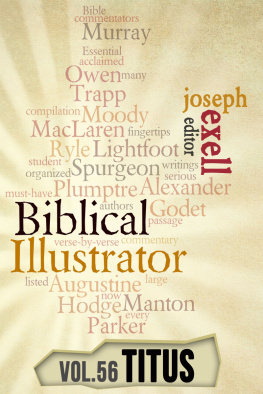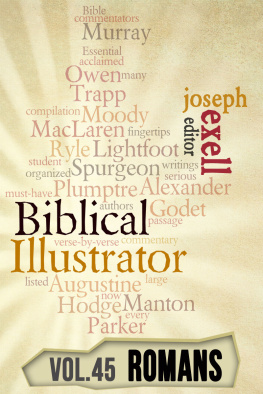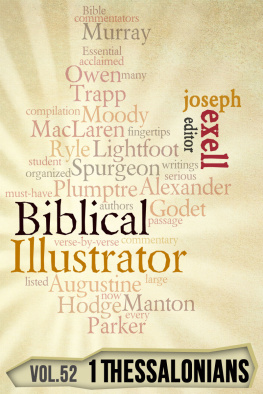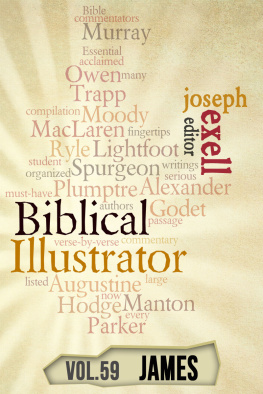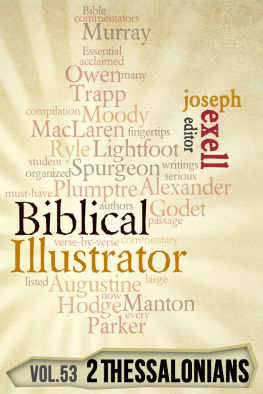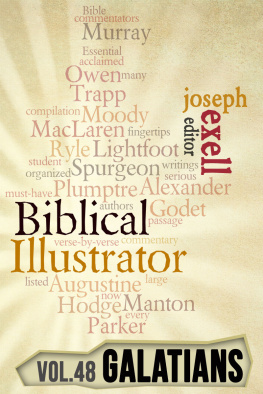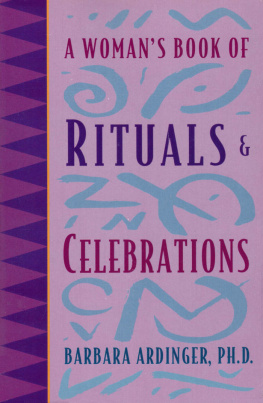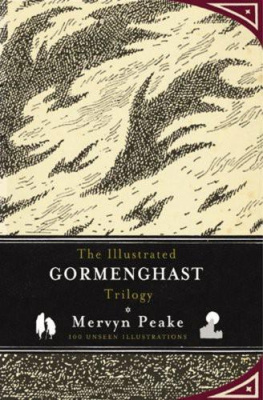Exell - The Biblical Illustrator - Titus
Here you can read online Exell - The Biblical Illustrator - Titus full text of the book (entire story) in english for free. Download pdf and epub, get meaning, cover and reviews about this ebook. genre: Religion. Description of the work, (preface) as well as reviews are available. Best literature library LitArk.com created for fans of good reading and offers a wide selection of genres:
Romance novel
Science fiction
Adventure
Detective
Science
History
Home and family
Prose
Art
Politics
Computer
Non-fiction
Religion
Business
Children
Humor
Choose a favorite category and find really read worthwhile books. Enjoy immersion in the world of imagination, feel the emotions of the characters or learn something new for yourself, make an fascinating discovery.
The Biblical Illustrator - Titus: summary, description and annotation
We offer to read an annotation, description, summary or preface (depends on what the author of the book "The Biblical Illustrator - Titus" wrote himself). If you haven't found the necessary information about the book — write in the comments, we will try to find it.
Exell: author's other books
Who wrote The Biblical Illustrator - Titus? Find out the surname, the name of the author of the book and a list of all author's works by series.
The Biblical Illustrator - Titus — read online for free the complete book (whole text) full work
Below is the text of the book, divided by pages. System saving the place of the last page read, allows you to conveniently read the book "The Biblical Illustrator - Titus" online for free, without having to search again every time where you left off. Put a bookmark, and you can go to the page where you finished reading at any time.
Font size:
Interval:
Bookmark:
What if Charles Spurgeon helped you prepare next Sundays sermon?
Or what if you could talk over your preaching with Joseph Parker, Richard Baxter, Henry Ward Beecher and H. P. Liddon. Do you think it would make a difference to get the input of some of the greatest preachers who ever lived?
Thats precisely what Joseph Exell had in mind when he put together the massive series of volumes called The Biblical Illustrator. In what can only be called a Herculean feat, he spent years gathering preaching notes and sermon outlines from the very best preachers of his day (in the late 1800s and early 1900s), and he did it covering every book of the Bible.
Following the tradition of the time, he gave the series a flowery subtitle, describing it as anecdotes, similes, emblems, illustrations, expository, scientific, geographic, historical and homiletic, gathered from a wide range of home and foreign literature, on the verses of the Bible. He means that in these volumes you have everything you need in order to preach a sermon, teach a Bible class, or study a text on your own.
And it is amazingly comprehensive. Exell approached his task by taking every verse in the Bible and seeking to discover how it has been preached in the past. Though there is plenty of exegetical material here, this is not primarily a commentary.
This series is for preachers, teachers and Bible students.
Besides obviously being an omnivorous reader, he had a gift for amazing diligence. The Biblical Illustrator was published in 66 volumes. To give you a sense of how comprehensive it is, volume 49 contains 588 pages on Galatians. And the type in the original version was very small, with narrow margins so you almost had to have a magnifying glass to read it. But Joseph Exell had something in mind other than publishing a stylish book. He wanted to give preachers a book so complete that you could give it to someone and say, Go preach Galatians, and they could do it.
No one could ever use all the sermon outlines in the Biblical Illustrator. But thats not the point. We all agree that the best preacher starts with your study of the biblical text. But at some point you need to know what others have seen in the same text you are studying.
What did Spurgeon see?
What did Parker see?
What did Alexander MacLaren see?
Maybe you will see the same thing they did. Probably you will see something similar. But its entirely possible that Spurgeon (who has a flair for memorable phrasing) captured the thought of the text in a way that never occurred to you.
And there are times when the preacher needs some help in priming the pump. We all know what its like to be stuck in some passage of the Bible. You know what it says, you have studied the words, you have read a few commentaries, but somehow the message isnt jelling in your mind. Thats where the Biblical Illustrator is likely to be most helpful to you. If you are preaching on, say, Hebrews 10:19-25, you can find real help in the Biblical Illustrator. There is an expanded sermon outline by J. Colwell that almost anyone could expand into a profitable message. There is a lengthy and intricate outline by the Puritan pastor Thomas Boston and a moving exposition of Christ our high priest by Adolph Saphir.
Thats just one tiny example of one text. And Joseph Exell does that for every text in the Bible.
Its a phenomenal piece of work, and one that stands up very well more than a century later. I know of no comparable collection that has been done since then. I doubt if anyone would have the time or energy to attempt such a massive project today.
I bought my first copy of the Biblical Illustrator almost 20 years. Back then it came in six or seven massive volumes, printed on oversized pages with type so tiny I could hardly read it. About 10 years ago I purchased a CD with the Biblical Illustrator in PDF format. That was a huge improvement. But with the advent of ebook technology, we at last have the Biblical Illustrator in its most useful format. Because it is indexed to each section of the book, you can quickly find the passage you are looking for. And you can enlarge the text as much as you like.
As you can tell, Im big fan of the Biblical Illustrator because it preserves the wisdom of an earlier age. I would fully agree that you must start with your own study of the text, and we definitely need the fruit of recent biblical commentaries. But alongside your own study and the reading of current commentaries, there is a large place for reading the Biblical Illustrator.
Joseph Exell wanted to help preachers, teachers, and everyday Bible students. He succeeded admirably in his task. The fruit of his labors is now available for the first time in ebook format, making it more usable today than when it was first published.
For those who want to study the Bible and then teach it to others, the Biblical Illustrator will help you on every single text in the Bible. For over a century preachers and teachers have turned to it and found what they needed. I gladly say that it has often helped me, and I am glad to commend this series to you.
Dr. Ray Pritchard
President, Keep Believing Ministries
April 2012
Dallas, TX
Extremely little is known of Titus, either as a man or as an evangelist. His name never occurs in the history of the Acts, which is somewhat strange, as we know, from the Epistle to the Galatians, that he was with Paul and Barnabas at Antioch, and accompanied them to Jerusalem when they went to have the dispute settled about circumcision (Galatians 2:1-3). We learn, from the brief notice given us of what took place on that occasion, that Paul sternly refused to have him circumcised, as some of the Jewish Christians wished, because he saw that in his case the principle of gospel liberty was at stake, and must, at whatever hazard, be vindicated. It therefore appears not only that Titus was a Gentile, but that he must also have been employed chiefly in ministering to the Gentiles, or to churches in which these formed the predominating element. He appears, at a later period, to have been with Paul and Timothy at Ephesus, doubtless sharing with these in the manifold labours attendant on the planting of the Church in that centre of idolatry and corruption. From Ephesus he was sent forth by Paul to Corinth, for the purpose of stimulating the brethren to get forward their contributions for the poor saints at Jerusalem (2 Corinthians 8:6; 12:18). He rejoined the apostle in Macedonia, and cheered him with the report he brought, not only of the progress of the contributions, but also of the salutary effect produced by the First Epistle of Paul to the Church at Corinth (1 Corinthians 7:6; 15). (P. Fairbairn, D. D.)
The love of apology, stimulating suggestion, and fatherly counsel manifested towards Timothy differs greatly from the manner of every reference to Titus, who evidently could take care of himself and be safely entrusted with intricate, difficult, and delicate negociations. St. Paul appears to have been more dependent upon Titus than Titus was upon Paul. He is described as the apostle's "brother and companion and fellow labourer" (2 Corinthians 8:23); and if he were the bearer of the First Epistle to the Corinthians, and enforced the advice of the apostle upon the Church which had for the moment been thrown into violent confusion by "that wicked person," he must have been a man of strong nerve and fine tact...Titus not only discharged his task with admirable...patience and success, but was ready, even eager, to go back to Corinth with the second letter, and to complete the delicate service which he had commenced a year before (cf. 2 Corinthians 8:6 with 12:18). Since he had begun, Paul desired him also to finish among the Corinthians the same grace or gift. The eager interest with which he responded to the appeal seemed like a Divine inspiration. "God," says Paul, "put it into his heart." A private letter addressed to Titus in the midst of these negociations would have possessed great interest; but we know nothing of his proceedings until many years have elapsed . (H. R. Reynolds, D. D.)
Font size:
Interval:
Bookmark:
Similar books «The Biblical Illustrator - Titus»
Look at similar books to The Biblical Illustrator - Titus. We have selected literature similar in name and meaning in the hope of providing readers with more options to find new, interesting, not yet read works.
Discussion, reviews of the book The Biblical Illustrator - Titus and just readers' own opinions. Leave your comments, write what you think about the work, its meaning or the main characters. Specify what exactly you liked and what you didn't like, and why you think so.

